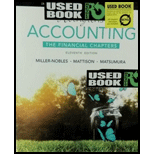
Concept introduction
Cash Ratio: Cash Ratio is a financial liquidity ratio that measures the ability of an organization to meet its short-term obligations with only cash and cash equivalents. It is measured as a ratio of total cash and cash equivalents to current liabilities.
Times-interest-earned Ratio: Times-interest-earned Ratio is a financial solvency ratio that measures an organization’s ability to meet its interest payments on debt with its available earnings before interest and tax. It is measured as a ratio of earnings before interest and tax (EBIT) to interest expense.
Inventory Turnover: Inventory Turnover is a financial efficiency ratio that indicates how effectively and efficiently an organization manages its inventory. It measures how many times an organization sells and replaces its inventory during a period. It is calculated by diving cost of goods sold by average inventory during a period.
Gross Profit Percentage: Gross Profit Percentage is a financial profitability ratio that shows the percentage of sales that exceed cost of goods sold. It is calculated by dividing gross profit which is net sales minus cost of goods sold, by net sales of a company for a particular period.
Debt Equity Ratio: Debt Equity Ratio is a financial leverage ratio that shows what proportion of debt an organization is using to finance its assets relative to shareholder’s equity. It is measured as a ratio of total debt to total
Return on Common Stockholders’ Equity: Return on Common Stockholders’ Equity (ROCE) is a financial profitability ratio that measures the ability of a company to generate profits with the money invested by its shareholders. It is calculated by dividing net income available to common stockholders by average common stockholders’ equity for a particular period.
Earnings per Share: Earnings per Share (EPS) is a financial profitability ratio that measures the amount of net income available to common stockholders earned on one share. It is calculated by dividing net income available to common stockholders by the average (or weighted average) number of shares outstanding during a period.
Price Earnings Ratio: Price Earnings Ratio is a financial ratio for valuing a company’s stock in the market that shows what the investors are willing to pay for $1 of the company’s earnings. It is measured as a ratio of market price per share of a company’s stock to the earnings per share for a particular period.
1.
To Compute: The given ratios for 2015 and 2016.
2.
To Decide: (a) Whether Canfield’s ability to pay debts and to sell inventory improved or deteriorated during 2016 and (b) whether the investment attractiveness of its common stock appears to have increased or decreased.
Want to see the full answer?
Check out a sample textbook solution
Chapter 17 Solutions
Horngren's Accounting, The Financial Chapters (11th Edition) - Standalone Book
- Einstein Corporation has budgeted a total overhead cost of $720,000 and budgeted machine hours of 60,000 for the upcoming period. During the actual period, the total overhead incurred was $750,000, and actual machine hours used were 65,000. Find the applied overhead for the period and determine whether the overhead is overapplied or underapplied. Show your step-by-step solution.arrow_forwardGhana company reported inventory of $60,000 at the beginning of 2023.arrow_forwardI am searching for the correct answer to this general accounting problem with proper accounting rules.arrow_forward
- Given the solution and financial accounting questionarrow_forwardArmour vacation cabin was destroyed by a wildfire. He had purchased the cabin 14 months ago for $625,000. He received $890,000 from his insurance company to replace the cabin. If he fails to rebuild the cabin or acquire a replacement property in the required time, how much gain must he recognize on this conversion? A. $375,000 B. $160,000 C. $265,000 D. $0 E. None of the above provide answerarrow_forwardCan you solve this general accounting question with accurate accounting calculations?arrow_forward
- Hello tutor please given General accounting question answer do fast and properly explain all answerarrow_forwardCan you explain the correct approach to solve this financial accounting question?arrow_forwardPlease help me solve this financial accounting problem with the correct financial process.arrow_forward

 AccountingAccountingISBN:9781337272094Author:WARREN, Carl S., Reeve, James M., Duchac, Jonathan E.Publisher:Cengage Learning,
AccountingAccountingISBN:9781337272094Author:WARREN, Carl S., Reeve, James M., Duchac, Jonathan E.Publisher:Cengage Learning, Accounting Information SystemsAccountingISBN:9781337619202Author:Hall, James A.Publisher:Cengage Learning,
Accounting Information SystemsAccountingISBN:9781337619202Author:Hall, James A.Publisher:Cengage Learning, Horngren's Cost Accounting: A Managerial Emphasis...AccountingISBN:9780134475585Author:Srikant M. Datar, Madhav V. RajanPublisher:PEARSON
Horngren's Cost Accounting: A Managerial Emphasis...AccountingISBN:9780134475585Author:Srikant M. Datar, Madhav V. RajanPublisher:PEARSON Intermediate AccountingAccountingISBN:9781259722660Author:J. David Spiceland, Mark W. Nelson, Wayne M ThomasPublisher:McGraw-Hill Education
Intermediate AccountingAccountingISBN:9781259722660Author:J. David Spiceland, Mark W. Nelson, Wayne M ThomasPublisher:McGraw-Hill Education Financial and Managerial AccountingAccountingISBN:9781259726705Author:John J Wild, Ken W. Shaw, Barbara Chiappetta Fundamental Accounting PrinciplesPublisher:McGraw-Hill Education
Financial and Managerial AccountingAccountingISBN:9781259726705Author:John J Wild, Ken W. Shaw, Barbara Chiappetta Fundamental Accounting PrinciplesPublisher:McGraw-Hill Education





